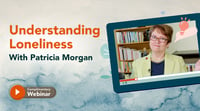“Loneliness is the discrepancy between what you have and what you want from your relationships.”
At first, the above quote seems quite obvious, but it explains a lot about the true state of loneliness. At a recent webinar with Patricia Morgan — a spunky senior-preneur and book author with her Masters in Clinical Psychology — spoke about what loneliness really is and how we can meaningfully relate to ourselves, our loved ones, and those we know who would benefit from an uplifting connection.
“The first step is to connect to yourself,” Patricia said. “The emotion of loneliness is tricky, because there is a stigma around it. Does being lonely make me a loser? The answer is no.”
If we look at loneliness as “the discrepancy between what you have and what you want from your relationships,” it becomes easy to see that the emotional need may vary widely from person to person. Someone with many friends may feel alone, and someone with few friends, who lives mostly in solitude, may not feel lonely at all.
Certain groups, such as seniors and persons living with disabilities, are at a higher risk of loneliness, according to Patricia. This can put them at a higher risk for higher alcohol use, sleep problems, weight gain or loss, immune system complication, depression, heart disease, unexplained emotions, and mental decline.
“I wish I knew what I now know about loneliness at the beginning of COVID,” Patricia said. She said that at this time, it has become harder to stay connected, and the political climate is only widening the gap between friends and families. Those who have strong conflicting opinions may find it hard to connect, despite the previous relationship they may have enjoyed.
“You can always say, ‘that’s interesting, tell me more about that,’ or just ‘that’s interesting,’” Patricia said. “Sometimes we may not see eye-to-eye, but we feel heart-to-heart.”
She also recommends finding other forms of constant communication when physical distancing is needed. Letters, phone calls, video calls, and social media are all tools that can be used. She shared that in a recent study, it was discovered that when people reached out to connect with someone they loved, they actually had a greater mood boost than if someone reached out to them. This was partially because it feels good to do something that makes someone else feel happy.
If you’re concerned about someone you love being lonely, Patricia said you can start by asking them “How do you really feel.” The addition of the word ‘really’ sets the phrase apart from the common greeting, which people may instinctively answer with “Fine.”
“Letting someone know ‘I see you. I hear you. And what you say matters to me’ can make a huge difference,” Patricia said.
She also spoke about the importance of touch. Hugs are necessary, according to Patricia. But when distance makes them a challenge, the same comfort can be found by interacting with a pet or hugging something soft — such as a stuffed animal, pillow, or blanket.
 Looking for more information? Get your e-copy of Patricia’s book, Understanding Loneliness, today!
Looking for more information? Get your e-copy of Patricia’s book, Understanding Loneliness, today!

.jpg)
